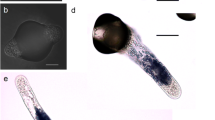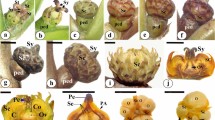Abstract
In Petunia inflata, as in other species that shed bicellular pollen, early pollen tube growth in the pistil is slow, then increases 2- to 5-fold depending on the genotype of the female parent. We refer to the time point at which pollen tubes enter the accelerated phase of growth as the pollen growth transition (PGT). Here, we present evidence that pre-PGT and post-PGT growth are quantitatively and qualitatively different, and that the PGT is triggered when pollen tubes reach the transition zone (TZ) below the stigma. The capacity of various pistil zones to precipitate the PGT was tested through 'stump' pollinations: varying lengths of the pistil apex were excised, the cut surface of the remaining pistil (the stump) coated with stigmatic exudates then dusted with compatible pollen. Pollen applied to TZ tissues entered the PGT earlier than pollen growing in intact control pistils; the PGT was delayed in stylar stumps, largely because of delayed germination and reduced pre-PGT growth. In immature pistils, the PGT was delayed by several hours relative to its onset in mature pistils. The PGT fails to occur in pollen cultured in vitro. Collectively, the data suggest that pollen tubes become competent to enter the PGT when they reach a critical size, but the physicochemical environment of the transmitting tissue is necessary for triggering the cellular changes that result in accelerated growth. An analysis of the distribution of pollen tube tips before and after the PGT suggests that pollen competition is most intense during the pre-PGT phase.





Similar content being viewed by others
References
Ai Y, Singh A, Coleman CE, Ioerger TR, Kheyr-Pour A, Kao T-h (1990) Self-incompatibility in Petunia inflata: isolation and characterization of cDNAs encoding three S-allele-associated proteins. Sex Plant Reprod 3:130–138
Atkinson AH, Heath RL, Simpson RJ, Clarke AE, Anderson MA (1993) Proteinase inhibitors in Nicotiana alata stigmas are derived from a precursor protein which is processed into five homologous inhibitors. Plant Cell 5:203–213
Brewbaker JL (1967) The distribution and phylogenetic significance of binucleate and trinucleate pollen grains in the angiosperms. Am J Bot 54:1069–1083
Brewbaker JL, Majumder SK (1961) Cultural studies of the pollen population effect and the self-incompatibility inhibition. Am J Bot 48:457–464
Budelier KA, Smith AG, Gasser CS (1990) Regulation of a stylar transmitting tissue-specific gene in wild-type and transgenic tomato and tobacco. Mol Gen Genet 224:183–192
Cheung AY, Wang H, Wu H-m (1995) A floral transmitting tissue-specific glycoprotein attracts pollen tubes and stimulates their growth. Cell 82:383–393
Cheung AY, Wu H-M, Di Stilio V, Glaven R, Chen C, Wong E, Ogdahl J, Estavillo A (2000) Pollen-pistil interactions in Nicotiana tabacum. Ann Bot 85:39–37
Constabel CP, Brisson N (1995) Stigma- and vascular-specific expression of the PR-10a gene of potato: a novel pattern of expression of a pathogenesis-related gene. Mol Plant Microbe Interact 8:104–113
Cruzan MB (1986) Pollen tube distributions in Nicotiana glauca: evidence for density dependent growth. Am J Bot 73:902–907
Derksen J, Rutten T, Lichtscheidl IK, de Win AHN, Pierson ES, Rongen G (1995a) Quantitative analysis of the distribution of organelles in tobacco pollen tubes: implications for exocytosis and endocytosis. Protoplasma 188:267–276
Derksen J, Rutten T, Van Amstel T, De Win A, Doris F, Steer M (1995b) Regulation of pollen tube growth. Acta Bot Neerl 44:93–119
Dixit R, Rizzo C, Nasrallah M, Nasrallah J (2001) The Brassica MIP-MOD gene encodes a functional water channel that is expressed in stigma epidermis. Plant Mol Biol 45: 51–62
Gasser CS, Robinson-Beers K (1993) Pistil development. Plant Cell 5:1231–1239
Gawel NJ, Rogacker CD (1986) Effect of pollen-style interaction on the pollen tube growth of Gossypium hirsutum. Theor Appl Genet 72:84–87
Graaf BHJ de, Derksen JWM, Mariani C (2001) Pollen and pistil in the progamic phase. Sex Plant Reprod 14:41–55
Herrero M, Dickinson HG (1979) Pollen-pistil incompatibility in Petunia hybrida: changes in the pistil following compatible and incompatible intraspecific crosses. J Cell Sci 36:1–18
Herrero M, Dickinson HG (1980) Pollen tube growth following compatible and incompatible intraspecific pollinations in Petunia hybrida. Planta 148:217–221
Herrero M, Dickinson HG (1981) Pollen tube development in Petunia hybrida following compatible and incompatible intraspecific matings. J Cell Sci 47:365–383
Herrero M, Hormaza JI (1996) Pistil strategies controlling pollen tube growth. Sex Plant Reprod 9:343–347
Holden MJ, Marty JA, Singh-Cundy A (2002) Pollination-induced ethylene promotes the early phase of pollen tube growth in Petunia inflata. J Plant Physiol (in press)
Hormaza JI, Herrero M (1994) Gametophytic competition and selection. In: Williams EG, Clarke EA, Knox RB (eds) Genetic control of self-incompatibility and reproductive development in flowering plants. Kluwer, Boston, pp 372–400
Jóhannsson MH, Stephenson AG (1997) Effects of pollination intensity on the vigor of the sporophytic and gametophytic generation of Cucurbita texana. Sex Plant Reprod 10:236–240
Konar RN, Linskens HF (1966) The morphology and anatomy of the stigma of Petunia hybrida. Planta 71:356–371
Li Y-Q, Moscatelli A, Cai G, Cresti M (1997) Functional interactions among cytoskeleton, membranes, and cell wall in the pollen tube of flowering plants. Int Rev Cytol 176:133–199
Lush WM, Opat AS, Nie F, Clarke AE (1997) An in vitro assay for assessing the effects of growth factors on Nicotiana alata pollen tubes. Sex Plant Reprod 10:351–357
Marshall DL, Folsom MW (1991) Mate choice in plants: an anatomical to population perspective. Annu Rev Ecol Syst 22:37–63
McCubbin AG, Kao T-h (2000) Molecular recognition and response in pollen and pistil interactions. Annu Rev Cell Dev Biol 16:333–364
Mu J-h, Lee H-S, Kao T-h (1994) Characterization of a pollen-expressed receptor-like kinase gene of Petunia inflata and the activity of its encoded kinase. Plant Cell 6:709–721
Mulcahy DL, Sari-Gorla M (1996) Pollen selection past, present and future. Sex Plant Reprod 9:353–356
Mulcahy GB, Mulcahy DL (1982) The two phases of growth of Petunia hybrida (Hort. Vilm-Andz.) pollen tubes through compatible styles. J Palynol 18:61–64
Mulcahy GB, Mulcahy DL (1983) A comparison of pollen tube growth in bi- and trinucleate pollen. In: Mulcahy DL, Ottaviano E (eds) Pollen: biology and implications for plant breeding. Elsevier, New York, pp 29–33
O'Brien M, Bertrand C, Matton DP (2002) Characterization of a fertilization-induced and developmentally regulated plasma-membrane aquaporin expressed in reproductive tissues, in the wild potato Solanum chacoense Bitt. Planta 215:485–493
Okendon DJ, Gates PJ (1975) Growth of cross- and self-pollen tubes in the styles of Brassica oleracea. New Phytol 75:155–160
O'Neill (1997) Pollination regulation of flower development. Annu Rev Plant Physiol Plant Mol Biol 48:547–574
Read SM, Clarke AE, Bacic A (1993) Requirements for division of the generative nucleus in cultured pollen tubes of Nicotiana. Protoplasma 174:101–115
Singh A, Evensen KB, Kao T-h (1992) Ethylene synthesis and floral senescence following compatible and incompatible pollinations in Petunia inflata. Plant Physiol 99:38–45
Stephenson AG, Hayes CN, Jóhannsson MH, Winsor JA (2001) The performance of microgametophytes is affected by inbreeding depression and hybrid vigor in the sporophytic generation. Sex Plant Reprod 14:77–83
Tang X, Gomes AMTR, Bhatia A, Woodson WR (1994) Pistil-specific and ethylene-regulated expression of 1-aminocyclopropane-1-carboxylate oxidase genes in Petunia flowers. Plant Cell 6:1227–1239
Wang H, Wu H-M, Cheung AY (1993) Development and pollination regulated accumulation and glycosylation of a stylar transmitting tissue-specific proline-rich protein. Plant Cell 5:1639–1650
Winsor JA, Stephenson AG (1995) Demographics of pollen tube growth in Cucurbita pepo. Can J Bot 73: 583–589
Wolters-Arts M, Derksen J, Kooijman JW, Mariani C (1996) Stigma development in Nicotiana tabacum. Cell death in transgenic plants as a marker to follow cell fate at high resolution. Sex Plant Reprod 9:243–254
Wolters-Arts M, Lush WM, Mariani C (1998) Lipids are required for directional pollen-tube growth. Nature 392:818–821
Wu H-m, Wong E, Ogdahl J, Cheung AY (2000) A pollen tube growth-promoting arabinogalactan protein from Nicotiana alata is similar to the tobacco TTS protein. Plant J 22:165–176
Acknowledgements
We thank undergraduate students Justin Foster, Irene Kloth, and Mandi Vaughn for enthusiastic participation in various aspects of the project. This work was supported by intramural grants from the Bureau of Faculty Research, Western Washington University.
Author information
Authors and Affiliations
Corresponding author
Rights and permissions
About this article
Cite this article
Lubliner, N., Singh-Cundy, D.T. & Singh-Cundy, A. Characterization of the pollen growth transition in self-incompatible Petunia inflata . Sex Plant Reprod 15, 243–253 (2003). https://doi.org/10.1007/s00497-002-0162-4
Received:
Accepted:
Published:
Issue Date:
DOI: https://doi.org/10.1007/s00497-002-0162-4




